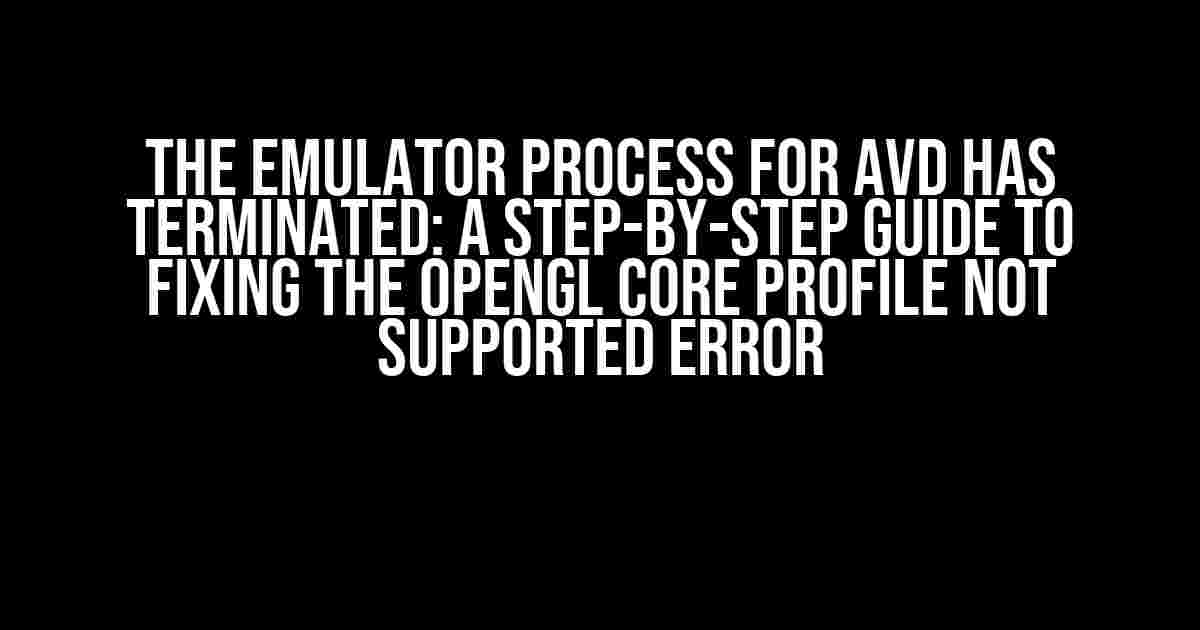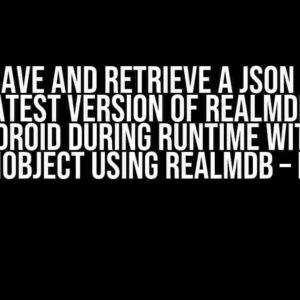Are you tired of encountering the frustrating “The emulator process for AVD has terminated” error while trying to run your Android Virtual Device (AVD)? You’re not alone! This pesky issue can be a major roadblock for developers, testers, and enthusiasts alike. But fear not, dear reader, for we’ve got you covered. In this comprehensive guide, we’ll delve into the root cause of the problem, explore the reasons behind the “OpenGL Core Profile not supported” error, and provide a detailed, step-by-step solution to get your AVD up and running in no time.
What Causes the “The Emulator Process for AVD has Terminated” Error?
The “The emulator process for AVD has terminated” error usually occurs when the Android Emulator is unable to initialize the graphics driver, resulting in a crash. This can be attributed to several factors, including:
- Incompatibility with the graphics card or driver
- Insufficient system resources (RAM, CPU, or GPU)
- Corrupted AVD configuration or system files
- Outdated or mismatched graphics drivers
- Conflicting software or background processes
Understanding the “OpenGL Core Profile not Supported” Error
The “OpenGL Core Profile not supported” error is often a symptom of a larger issue related to the graphics driver or system capabilities. OpenGL is a cross-language, cross-platform API for rendering 2D and 3D graphics. The Core Profile is a specific implementation of OpenGL that provides a more efficient and streamlined way of rendering graphics. However, not all graphics cards or drivers support the Core Profile, leading to conflicts with the Android Emulator.
Step-by-Step Solution to Fix the “The Emulator Process for AVD has Terminated” Error
Follow these instructions carefully to resolve the “The emulator process for AVD has terminated” error and get your AVD up and running:
Step 1: Update Your Graphics Driver
Outdated or mismatched graphics drivers can cause compatibility issues with the Android Emulator. Updates often include bug fixes, performance enhancements, and support for newer APIs like OpenGL Core Profile. Follow these steps to update your graphics driver:
- Identify your graphics card model and manufacturer (e.g., NVIDIA, AMD, Intel)
- Visit the manufacturer’s website and navigate to the driver download section
- Download the latest driver compatible with your operating system (Windows, macOS, or Linux)
- Install the driver and follow the on-screen instructions
Step 2: Disable Hardware Acceleration
Sometimes, hardware acceleration can cause issues with the Android Emulator. Try disabling it to see if it resolves the problem:
- Open the Android Studio or your preferred IDE
- Navigate to
Tools>Android>AVD Manager - Select the problematic AVD and click
Edit this AVD - In the
Verify Configurationdialog, uncheck theUse Host GPUoption - Click
Finishand try running the AVD again
Step 3: Modify the Emulator Config File
Editing the emulator config file can help resolve the OpenGL Core Profile issue. You’ll need to add a few lines of code to force the emulator to use a compatible graphics mode:
<config>
...
<gfx>
<mode>swiftshader</mode>
</gfx>
</config>
Follow these steps to modify the config file:
- Locate the emulator config file (usually
~/.android/avd/[AVD_NAME].avd/config.ini) - Open the file in a text editor (e.g., Notepad++, Sublime Text)
- Save the changes and try running the AVD again
Step 4: Run the Emulator with the -gpu Command-Line Argument
Running the emulator with the -gpu command-line argument can help resolve the OpenGL Core Profile issue. You’ll need to specify the compatible graphics mode:
emulator -avd [AVD_NAME] -gpu swiftshader
Follow these steps to run the emulator with the -gpu argument:
- Open a command prompt or terminal window
- Navigate to the Android SDK directory (usually
~/.android/sdk/tools) - Run the above command, replacing
[AVD_NAME]with your AVD’s name - The emulator should launch with the specified graphics mode
Step 5: Create a New AVD with a Compatible Configuration
If none of the above steps resolve the issue, it’s possible that your AVD configuration is corrupted or incompatible. Try creating a new AVD with a compatible configuration:
- Open the Android Studio or your preferred IDE
- Navigate to
Tools>Android>AVD Manager - Click
Create Virtual Deviceand follow the wizard - Select a device configuration that matches your system’s capabilities
- Choose a system image that supports OpenGL Core Profile (e.g., Android 10.0 or later)
- Click
Finishto create the new AVD
Conclusion
The “The emulator process for AVD has terminated” error, caused by the “OpenGL Core Profile not supported” issue, can be frustrating, but it’s not insurmountable. By following the steps outlined in this guide, you should be able to resolve the problem and get your AVD up and running. Remember to keep your graphics driver up to date, disable hardware acceleration if necessary, and modify the emulator config file to force a compatible graphics mode. If all else fails, create a new AVD with a compatible configuration. Happy coding!
| Common Errors | Solutions |
|---|---|
| The emulator process for AVD has terminated | Update graphics driver, disable hardware acceleration, modify emulator config file, or create a new AVD |
| OpenGL Core Profile not supported | Force compatible graphics mode using -gpu argument or modify emulator config file |
Still facing issues? Try searching for more specific error messages or consulting the official Android documentation for further troubleshooting guides.
Frequently Asked Question
Stuck with the emulator process for AVD terminating (OpenGL Core Profile not supported) error? Worry not, we’ve got you covered!
What does the “OpenGL Core Profile not supported” error mean?
This error occurs when your computer’s graphics driver does not support OpenGL Core Profile, which is required by the Android Emulator to run. It’s not a problem with your AVD or Android Studio installation, but rather a limitation of your computer’s hardware.
Why does the emulator process terminate with this error?
When the emulator is launched, it attempts to use the OpenGL Core Profile to render graphics. If your computer’s graphics driver does not support this profile, the emulator process will terminate, and you’ll see this error message.
Can I still use the Android Emulator with this error?
Unfortunately, no. The Android Emulator requires OpenGL Core Profile to function, so you’ll need to find an alternative solution, such as using a physical Android device for testing or a cloud-based emulator service that supports OpenGL Core Profile.
How do I fix the “OpenGL Core Profile not supported” error?
You’ll need to update your computer’s graphics driver to a version that supports OpenGL Core Profile. You can check with your computer manufacturer or graphics card provider for updates. Alternatively, consider using a cloud-based emulator service that supports OpenGL Core Profile.
Is there a workaround to use the Android Emulator with low-end graphics hardware?
While there’s no official workaround, you can try using the “Software” or ” SwiftShader” graphics mode in the Android Emulator settings. This will render graphics using software emulation, but it may impact performance. Keep in mind that this is not an official solution and may not work for all use cases.


